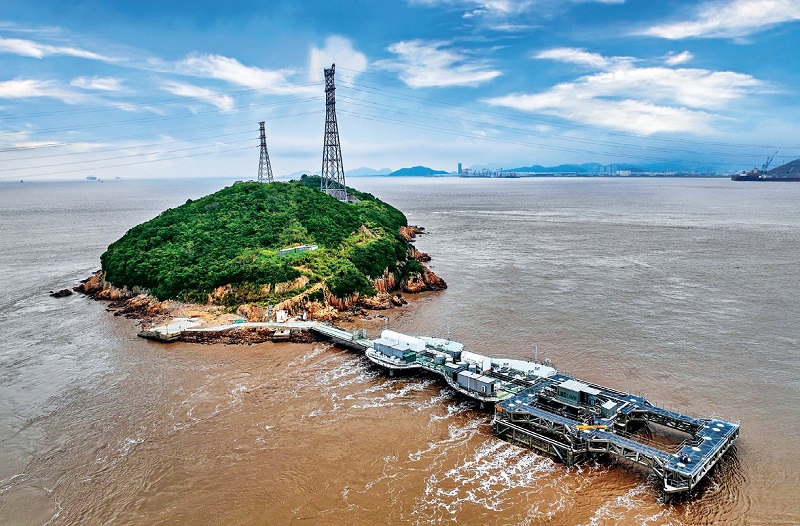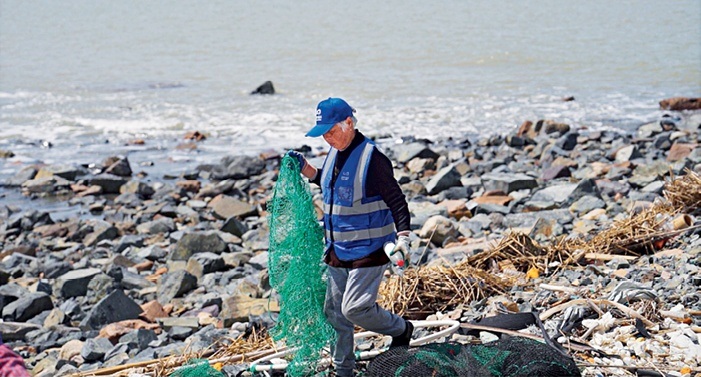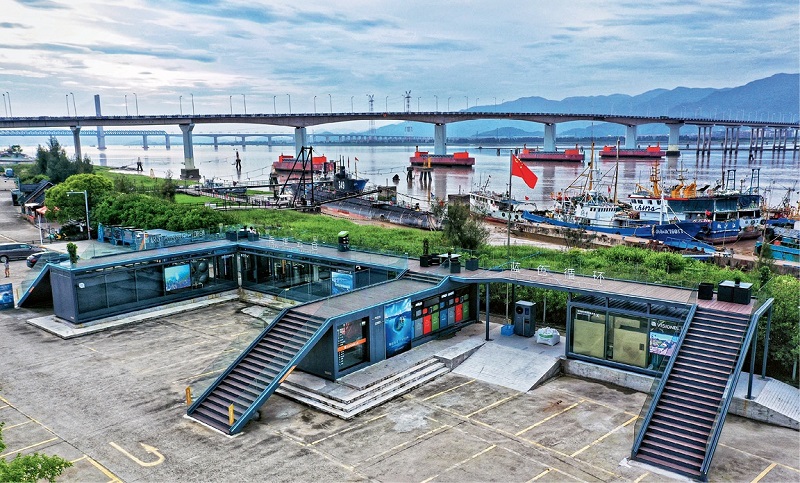Driven by the highly potential “blue market,” China’s coastal provinces are now taking measures to promote marine economy development.
In 2024, the total output of China’s marine economy demonstrated a strong growth momentum by exceeding RMB 10 trillion for the first time. During the first half of 2025, according to data released by the Ministry of Natural Resources, China’s gross ocean product (GOP) reached RMB 5.1 trillion, a year-on-year increase of 5.8 percent. The marine industry continues to see stable growth, becoming an important driving force for economic development.
East China’s Zhejiang Province boasts a vast expanse of sea area reaching 260,000 square kilometers, a 6,486-kilometer-long coastline, and 4,370 islands, ranking first in the nation in terms of island numbers. In January 2024, the nation’s first provincial-level department of marine economic development was established in Zhejiang, with the goal of pooling together superior resources to construct it into a strong marine province. Since the beginning of 2025, Zhejiang has been implementing a marine economy doubling action plan, to ensure that the growth rate of its GOP is one percentage point higher than that of its GDP.

LHD marine tidal current energy power station. Tang Zhicheng
Breakthroughs in Marine Technology
In the south of Xiushan Island, Zhejiang’s Zhoushan City, a massive steel structure resembling a silver violin is stretched across the turbulent currents. This is the LHD Zhoushan Tidal Current Power Station.
“In September last year, the LHD power station was certified by the International Energy Agency as the only one of its kind in the world, with the core standard being uninterrupted grid-connected power transmission for over one year,” said Lin Dong, director and chief engineer of LHD.
Previously, the one MW units jointly developed by international giants such as General Electric of the United States, Rolls-Royce of the United Kingdom, and Alstom of France, as well as the one MW units developed by France’s DCNS Group (now Naval Group), all had a maximum continuous grid-connected operation time of less than four months, with a levelized cost of electricity (LCOE) reaching as high as RMB 1,916 per kWh.
“We have not only solved the global challenge of achieving continuous and stable power generation from tidal energy but also achieved four technological iterations, reducing the cost of power generation from RMB 106 to RMB 1.1 per kWh,” Lin said proudly.
Behind these amazing breakthroughs, lie years of research and development. Since 2009, Lin has led a team of overseas-returnee scientists in conducting tidal energy research. In 2016, the first LHD marine tidal energy power station was built in Zhoushan, and its first-generation units were successfully functional and connected to the national grid. This marked three major breakthroughs in China’s marine energy development: high-power generation, stable generation, and grid integration.
After three subsequent upgrades, the LHD fourth-generation 1.6 MW “Fenjin” units, which boasts the world’s largest single-unit capacity, were connected to the grid in April 2022. As of the end of July this year, the LHD power station had been connected to the grid for over eight years, supplying more than 8.61 million kilowatt-hours of clean electricity to the national grid.
The LHD power station is now setting even higher goals. “We are confident that we can develop the fifth-generation units for application in the Heichao water area of the East China Sea. By then, the cost of power generation is expected to drop below RMB 0.3 per kWh, cheaper than thermal power,” Lin said.
The success of the LHD power station has also attracted international attention. Jiang Fang, vice president of Hangzhou LHD New Energy Technology Co., the operator of the power station, revealed that scholars and entrepreneurs from multiple countries, including Canada, France, Japan, and the U.K., have visited the LHD power station to explore collaboration possibilities. In May 2024, during President Xi Jinping’s state visit to France, the two nations issued the Sino-French Joint Statement on Strengthening Cooperation in Biodiversity and the Ocean: From Kunming-Montreal to Nice. Article 35 in the joint statement specifically mentions that “the two sides will exchange views on the production of marine renewable energy, particularly the rapidly developing offshore wind power, floating wind power, as well as tidal and wave energy, through their energy dialogue.”
“As tidal energy cooperation rises to the level of international strategy, the LHD power station will cooperate with more countries in the future to contribute Chinese wisdom to the unlocking of the treasure trove of marine energy,” said Jiang.
The innovative practices of the LHD power station echo Zhejiang’s forward-thinking strategy for cutting-edge marine technology. The Zhejiang Province Marine Science and Technology Innovation Capability Enhancement Action Plan (2025-2027) explicitly prioritizes innovation. It proposes the implementation of four major initiatives: enhancing the capability of sci-tech innovation platforms, tackling key core technologies, strengthening the
ecosystem for innovation entities, and attracting and cultivating innovative talent, all aimed at accelerating the innovation of marine science and technology.

A participant in the “Blue Cycle” project collects ocean trash along the coast of Taizhou, Zhejiang. Courtesy of the Publicity Department of the CPC Taizhou Municipal Committee
The Systematic Rise of Modern Marine Industry
On August 5, the signing ceremony for the Xiangshan County Blue Carbon Development and Management Entrustment Agreement was held on the shores of the Xihu Port. “The integration of the usage rights from five blue carbon development rights holders, which are uniformly entrusted to one professional operator, aims to facilitate, and systematize future blue carbon trading,” said Hu Shengmin, deputy director of the Ningbo Xiangshan County Development and Reform Bureau.
Blue carbon refers to the process and mechanism by which marine activities and organisms absorb, fix, and store atmospheric carbon dioxide. Xiangshan County boasts the longest coastline and the second-largest sea area in Zhejiang Province, harboring abundant blue carbon resources such as the yellow croaker, tea, and the “Xihu Three Treasures” (laver, kelp, and enteromorpha prolifera), providing exceptional conditions for developing the blue carbon economy.
In recent years, the county has actively explored means for promoting blue carbon development. In February 2023, China’s first blue carbon auction transaction was finalized there. In March 2024, the county launched the nation’s first “Double Carbon One-Stop Service”, and jointly established the country’s first cross-provincial blue carbon ecological carbon account with Xiamen City in its neighboring Fujian Province, completing Zhejiang Province’s first “Blue Carbon + Property Rights + Judiciary” transaction. The transaction originated from an ecological damage compensation case caused by illegal fishing, where the defendant voluntarily purchased 422.5 tons of blue carbon ecological products to be deposited into this account.
According to Hu, through developing the blue carbon economy, Xiangshan County has been able to effectively boost related industries such as marine eco-tourism and marine equipment manufacturing, injecting new momentum into economic growth as a result. Currently, the county is developing eight major marine industries: functional materials, clean energy, offshore engineering manufacturing, port-side equipment, modern fisheries, marine biotechnology, coastal tourism, and aerospace & marine information, and has nurtured a group of leading enterprises such as Ginlang Technology and Rixing Casting.
In late 2024, the Zhejiang Provincial Department of Marine Economic Development released the Cultivation List of the First Batch of Zhejiang Provincial Marine Industry Quality and Efficiency Enhancement and Doubling Platforms. This initiative aims to focus on the characteristics and future development direction of Zhejiang’s marine industry, and integrate policy resources from the provincial, municipal, and county levels to achieve that end.
The progress of the first 16 platforms has been significant. Yuhuan in Taizhou City, by extending, supplementing, and strengthening the industrial chain, has attracted over 600 enterprises to move into the area. Daishan in Zhoushan City, leveraging the spillover effects of a world-class petrochemical base, has seen several petrochemical new material projects included in provincial-level and above science and technology plans. Jiangbei in Ningbo City has focused on its strengths in shipping services, promoting as a result the innovative integration of “port & shipping + digital” and “port & shipping + commercial services.”

A “Blue Cycle” Marine Waste Disposal Base in Jiaojiang District, Taizhou City. Courtesy of the Publicity Department of the CPC Taizhou Municipal Committee
Guarding the Blue
In June of this year, at the United Nations Ocean Conference held in Nice, France, an elegant silk scarf printed with patterns of marine life attracted the attention of many attendees. Through scanning the QR code on the scarf’s tag, people can watch a video of a moving story about how raw materials from five plastic bottles that were collected by elderly individuals on a beach were creatively transformed into a fashion item by five women.
This scarf came from Zhejiang Vision Blue Technology Co., a participating enterprise at the conference. In 2021, Vision Blue launched a pilot “Blue Cycle” project in Taizhou. On one hand, the project mobilizes coastal residents and fishermen by offering them above-market prices to collect discarded plastic bottles from the ocean. On the other hand, leveraging IoT and blockchain technology, it has established a fully visual traceability and anti-counterfeiting certification platform which covers the entire process of “collection, storage, transportation, recycling, and manufacturing.” This platform has obtained international certification, turning discarded plastic bottles into low-carbon raw materials.
The “Blue Cycle” project has also earned high international acclaim for its innovative methods of tackling the challenge of marine plastic pollution. In October 2023, it was awarded the UN highest environmental honor, the “Champions of the Earth Award.” This model has now been extended to all coastal areas of Zhejiang Province, collecting approximately 58,800 tons of marine plastic waste and reducing carbon emissions by about 12,500 tons. It has also been replicated in other coastal provinces such as Shandong, Fujian, and Hainan.
To safeguard the “Blue Cycle”, on July 31, the 18th meeting of the Standing Committee of the 14th Zhejiang Provincial People’s Congress approved the Regulations on the Governance of Marine Plastic Waste in Taizhou, which will officially take effect on October 1 of this year.
“This is the first local regulation on marine plastic waste governance in China to institutionalize the ‘Blue Cycle’ model. It will facilitate the sustainable development of this model,” said Wang An, head of the marine ecological environment office of the Taizhou Municipal Ecology and Environment Bureau.
Ma Shengcong, deputy director of the Department of Ecology and Environment of Zhejiang Province, said that Zhejiang has always placed importance on marine ecological civilization construction. Taizhou’s “Blue Cycle” project is a vivid example of Zhejiang’s innovative practices in marine ecological protection. Zhejiang will keep exploring innovative governance models for the marine eco-environment, so that the sea stays bluer and the beaches more beautiful, and local people gain a stronger sense of happiness and security from better ocean stewardship.